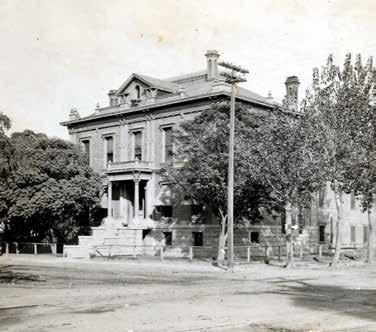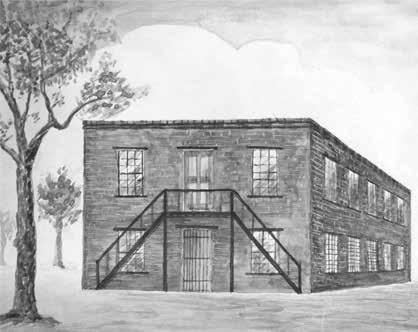
10 minute read
Word Play
NEWS ON WRITING, BOOKS
TEXT BY DIANE SLOCUM + THE WORLD OF PUBLISHING
Why is this called a “leap” year? Wiktionary suggests that it is because any given date will skip a weekday after Feb. 29. In 2018, March 1 was Thursday; last year, it was Friday; this year, it is Sunday, leaping over Saturday. To find a load of books related to leap year, you can leap over to leapyearday.com.
For instance, “Mommy, Where’s My Birthday?” by Lakisha Cornell discusses what to tell a child when his birthday is only on the calendar once every four years.
Kenneth Stevens’ “February the 29th” is a book of adventure geared toward 8- to 12-year-olds. Toby has to leave home on Feb. 29, his 12th (or is it third?) birthday because his mother is in the hospital. He is sent to his eccentric Uncle Nichol’s rural Scottish home, where the adventure begins.
“Leap Year: How small steps can make a giant difference” by Helen Russell gives ideas on how to make big decisions and welcome change, whether it involves where you live, your work, relationships or other aspects of life.
LEAP DAY WRITERS John Byrom (born Feb. 29, 1692), an English poet, wrote the lyrics for the hymn “Christians Awake.” He also invented a system of shorthand. Sedley Brown (born Feb. 29, 1856) was an American playwright, author and stage director. Occasionally, he acted in silent films. His twin brother, J. Edwin, was an actor.
Howard Nemerov (born Feb. 29, 1920) was twice the Library of Congress’ Poet Laureate (in 1963 and 1988). He won the Pulitzer Prize, National Book Award and Bollingen Prize. His best-known poem is “A Primer of the Daily Round.”
Patricia Anne McKillip (born Feb 29, 1948) is an American writer of fantasy and science fiction. Her awards include Bram Stoker, World Fantasy Life Achievement and Mythopoeic Fantasy. “The Forgotten Beasts of Eld” was her first novel.
VALLEY WRITERS Julie Appelbaum has published her second book of poetry, “Thriving in the Thicket.” She describes it as being “about finding one's path through life's thicket.” Rather than becoming stymied by fear, doubt and conflict, her poems suggest “proceeding through it with light, hope and joy. The poems reach to pull the reader to a better plane.” Her book leads off with “A Glimpse Ahead:”
Arise! Let hope beckon and light shine. Stand aside as joy like a berry ripens on a lush pathway bush, feeding you its good.
Besides her poems, the 100-page book includes questions and quotes chosen from well-known thinkers. Its ISBN # is 9781689401258, and it is available on Amazon.com.
Poet Brynn Saito has launched her chapbook and online letter archive titled “Dear —.“ The launch event on Feb. 8 included a community reading commemorating the Day of Remembrance. “Dear –“ is an archive of letters related to the incarceration of Americans of Japanese descent during World War II. Saito worked on the project in conjunction with Densho, a Seattle-based organization dedicated to preserving stories of the incarceration and to inspire equality for all.
Saito’s grandparents were among Central Valley residents who were forced out of their homes and imprisoned far from their farms, businesses and friends. They met, married and gave birth to their first child while held on the tribal land of the Gila River Indian community in southern Arizona.
READ THE BOOK “Killers of the Flower Moon: The Osage Murders and the Birth of the FBI” (Vintage Press, 2017) by David Grann was named the best book of 2018 by a long list of publications, led by Time Magazine, Wall Street Journal and the Smithsonian. It tells the true story of the Osage Nation in Oklahoma, who were the richest people in the world after oil was discovered on their land in the 1920s. Then someone started killing them. The motion picture adapted from the book stars Leonardo DiCaprio and Robert De Niro.
WRITING WORKSHOPS The Community of Writers is celebrating 50 years in the High Sierra. Summer writing workshops will be held for poetry, fiction, nonfiction and memoir in Squaw Valley at Lake Tahoe. Application deadline is March 28. Details: communityofwriters. org.
THE LAST WORD “A strange amazing day that comes only once every four years. For the rest of the time it does not ‘exist.’” — Vera Nazarian L

VISALIA'S LONG HISTORY OF JAILBREAKS
TEXT AND PHOTOS SUBMITTED BY TERRY L. OMMEN
There is something about being locked up in a jail cell that makes the person inside want to get out. Maybe it’s the small space, the loss of freedom, an irritating cellmate or a combination, but the urge to depart can often be strong. Of course, the vast majority of prisoners begrudgingly wait for their release date, but a few decide to make an early run for it. It is true today and was true historically.
Jail escapes are as old as the jails themselves. In fact, the Bible tells us that Peter left his jail cell early without permission after King Herod had put him there. Yes, “divine intervention” played an important part in St. Peter’s escape, but the use of outside help is not uncommon.
Jailbreaks happened throughout the world, and local lockups were not immune. In May 1870, an escape from the Tulare County Jail in Visalia became statewide news when the Sacramento Daily Union reported, “On Saturday evening, May 14 all the prisoners in the county jail at Visalia, four in number, escaped by digging through the heavy brick wall in the rear.” Probably the most famous jailbreak in county history took place in Visalia on the evening of Sept. 27, 1891, when Grat Dalton, convicted of attempted train robbery, and several others sawed through the bars of the new county jail and made a run for it. Dalton fled the county amid a hail of gunfire and headed east. But despite Grat’s lucky escape, his good fortune did not last. A year later, he and others were killed in a foiled bank robbery attempt in Coffeeville, Kansas.
That jailbreak highlighted the deficiencies of the facility and started it on a road to replacement. After only 28 years of use, the 1890 county lockup was on the chopping block.

James Hume, one of California’s top lawmen, played a part. At one time, he had gone on record saying, “I have been in every jail on the coast and am familiar with all of them. I have been acquainted with jails the greater part of my life, and I do not hesitate to pronounce the Visalia jail the worst constructed one I ever saw.” In 1918, a new county jail building replaced the old one on the northeast corner of Oak Avenue and Church Street, and it remains standing today.
About 10 years after this new county jail opened, an inmate who served as a trusty walked from the facility to empty a garbage can and did not return. An attempt was made to find him, but the authorities could not. But apparently the man’s conscience began to bother him and in April 1929, about a year after his escape, he turned himself in. His surrender earned him another jail cell and a new criminal charge for escape.
Five years later, a Lindsay man was arrested on forgery charges and brought to the county jail. As he was being processed, the booking deputy turned his back, and the man quickly hurried out the door, down the jail steps and ran north on Church. At the same time, Deputy Paul Reese had just arrived for work. He saw the suspicious man running and a chase ensued. Reese caught him at a residence near School Avenue, stuck his finger into his back and said, “If you try to get away, I’ll kill you.” Reese escorted the man back to the jail. He was placed in a cell and the fooled inmate told his cellmate, “If I had known that
Built in 1890, this Tulare County Jail stood until 1917, when it was replaced with the building that stands today at Oak Avenue and Church Street. It was from this building that Grat Dalton escaped in 1891. Circa 1895


2020


SUPPORTING THE VISALIA COUNTY CENTER ROTARY COMMUNITY SUPPORT ASSOCIATION
A FUNDRAISING EVENT AT THE VISALIA COUNTRY CLUB SAVE THE DATE April 18, 2020

Come join us for this popular, top-notch food and wine tasting experience. Spread over Visalia Country Club’s spacious Club House and lawns, guests socialize and wander among the delicious food and over 15 wineries. Enjoy views of the lush golf course, stately oak trees, water fountains, and swans e ortlessly drifting in the pond that fronts the 16th green while bidding on exciting auction items. For more information, please visit: www.vccrwineauction.com
fellow didn’t have a gun, I’d have been halfway to San Francisco by now.”
In 1940, another escape occurred, this time involving more violence. On Dec. 4, the Visalia Times-Delta reported the incident with the headline, “Three Youthful Desperadoes Slug Deputy Sheriff and Escape From County Jail.” The Porterville men were in jail on a combination of serious charges. As Deputy Sheriff Frank Kirkman was delivering “commissary,” the men attacked him with a mop handle. They ran out of the building and disappeared. Thirty-six hours after the escape, the men were back in custody thanks to observant deputies.
And the escapes and attempts continued through the decade of the 1950s. The year 1954 was tough for the Tulare County Sheriff’s Office. In February, an inmate escaped from jail and ended up in Massachusetts, where he was eventually arrested. In June the same year, two more prisoners, who shared a secondstory cell, broke out. At about 1 a.m. June 2, the young men removed a few loose bricks from a wall and pried others out with a mop handle. When the hole was large enough, the two wriggled through and dropped 20 feet to their freedom. Authorities suspected that they were in a stolen car. The next day, they were spotted, and eight police vehicles began the pursuit near Porterville and captured the escapees when they “spun out.”

One of the largest jailbreaks in Tulare County history took place on Feb. 23, 1957. Five men attacked a deputy delivering a mattress to their cell. They took the deputy’s jail keys and escaped. Within a week, four of the escapees were back in custody. In November 1957, two more inmates escaped and in September 1959, five prisoners were caught attempting to break out. They had tried to remove bricks from a wall in the jail and sawed through one of the bars, but they were discovered and did not get out of the building.
By the end of the 1950s, the 1918 jail building had been through a lot. It had housed hundreds, if not thousands, of prisoners, oftentimes in overcrowded conditions and with staff shortages.
By 1962, relief had arrived for the old timer, and a more modern county jail was built on Burrel Avenue just west of Mooney Boulevard.
For 44 years, the jail at Oak and Church
had served its purpose and deserved a
rest. In retirement, it has housed an art gallery, office space and restaurants. L
















